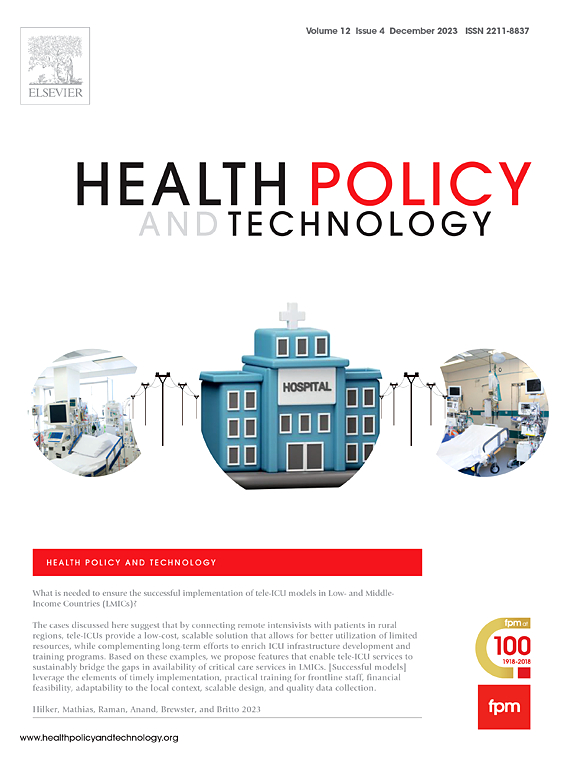Spillover effects of pain medication tapering in chronic pain patients: a systematic review and consequences for health economic evaluation studies
IF 3.7
3区 医学
Q1 HEALTH POLICY & SERVICES
引用次数: 0
Abstract
Background
Spillover effects of pain medication tapering (PMT) programs in patients with chronic pain (CP) are underexplored. This systematic review presents current research on the study of spillover effects of PMT in patients with CP and provides suggestions for examination of spillover effects in health economic research of PMT. Understanding spillover effects enable wide-ranging assessment of interventions, including its broader impacts.
Methods
Literature was searched up to September 2023 in Web of Science, PubMed, Scopus, Embase, PsychINFO, APA PsychNet, Cochrane library, Econlit, and grey literature sources including Google Scholar, CADTH, Mednar and the WHO website. QualSyst was used for Risk of bias assessment. The study protocol was registered prospectively in PROSPERO (CRD42023461763). Results were classified into five domains and incorporated into the expanded impact inventory framework. No funding was obtained.
Results
Of 2099 records initially identified, six qualitative studies of varying quality were included. In the healthcare domain, additional demands on healthcare delivery, patients switching between healthcare providers and psychosocial impacts for healthcare providers were key findings. Scientific spillovers entailed evidence-based recommendations, enhanced PMT awareness and knowledge dissemination. Sociological effects encompassed bias affecting underrepresented groups and community-level benefits. No spillovers were found in other categories. Future research should extend beyond patient-centered outcomes to comprehensively assess PMT’s societal impact and reveal indirect benefits currently underrepresented in the literature.
Conclusions
Spillover effects of PMT in patients with CP were identified. Considering spillovers can allow policymakers to optimize healthcare policies and resource allocation in healthcare. Inclusion of only six studies is a limitation of this study.
慢性疼痛患者止痛药减量的溢出效应:健康经济评价研究的系统回顾和后果
背景:慢性疼痛(CP)患者的疼痛药物减量(PMT)计划的溢出效应尚未得到充分研究。本文系统综述了PMT对CP患者溢出效应的研究现状,并对PMT在健康经济学研究中的溢出效应研究提出了建议。了解溢出效应有助于对干预措施进行广泛评估,包括其更广泛的影响。方法在Web of Science、PubMed、Scopus、Embase、PsychINFO、APA PsychNet、Cochrane library、Econlit以及谷歌Scholar、CADTH、Mednar和WHO网站等灰色文献源中检索截至2023年9月的文献。使用QualSyst进行偏倚风险评估。该研究方案在PROSPERO中前瞻性注册(CRD42023461763)。结果被分为五个领域,并纳入扩大的影响清单框架。没有获得资金。结果在最初确定的2099份记录中,纳入了6份不同质量的定性研究。在医疗保健领域,对医疗保健服务的额外需求、患者在医疗保健提供者之间的转换以及对医疗保健提供者的心理社会影响是主要发现。科学溢出效应包括基于证据的建议、加强对PMT的认识和知识传播。社会学效应包括影响代表性不足群体和社区层面利益的偏见。其他类别没有发现溢出效应。未来的研究应超越以患者为中心的结果,全面评估PMT的社会影响,并揭示目前文献中未充分代表的间接益处。结论PMT在CP患者中的外溢效应是明确的。考虑溢出效应可以使决策者优化医疗保健政策和医疗保健资源配置。仅纳入6项研究是本研究的局限性。
本文章由计算机程序翻译,如有差异,请以英文原文为准。
求助全文
约1分钟内获得全文
求助全文
来源期刊

Health Policy and Technology
Medicine-Health Policy
CiteScore
9.20
自引率
3.30%
发文量
78
审稿时长
88 days
期刊介绍:
Health Policy and Technology (HPT), is the official journal of the Fellowship of Postgraduate Medicine (FPM), a cross-disciplinary journal, which focuses on past, present and future health policy and the role of technology in clinical and non-clinical national and international health environments.
HPT provides a further excellent way for the FPM to continue to make important national and international contributions to development of policy and practice within medicine and related disciplines. The aim of HPT is to publish relevant, timely and accessible articles and commentaries to support policy-makers, health professionals, health technology providers, patient groups and academia interested in health policy and technology.
Topics covered by HPT will include:
- Health technology, including drug discovery, diagnostics, medicines, devices, therapeutic delivery and eHealth systems
- Cross-national comparisons on health policy using evidence-based approaches
- National studies on health policy to determine the outcomes of technology-driven initiatives
- Cross-border eHealth including health tourism
- The digital divide in mobility, access and affordability of healthcare
- Health technology assessment (HTA) methods and tools for evaluating the effectiveness of clinical and non-clinical health technologies
- Health and eHealth indicators and benchmarks (measure/metrics) for understanding the adoption and diffusion of health technologies
- Health and eHealth models and frameworks to support policy-makers and other stakeholders in decision-making
- Stakeholder engagement with health technologies (clinical and patient/citizen buy-in)
- Regulation and health economics
 求助内容:
求助内容: 应助结果提醒方式:
应助结果提醒方式:


